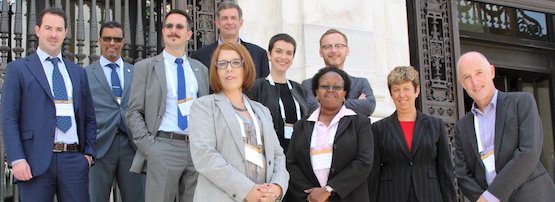
Last month, I was invited to Washington D.C. for the first annual meeting of the Global Forum on Cyber Expertise (GFCE).
The GFCE was proposed during the Global Conference on Cyberspace (GCCS) as a cooperative effort to assist human capacity building for cybersecurity – for instance, through access to training, technical support and tools. Its main aim is to translate the discussions at the GCCS into concrete action, promoting practical cooperation and reducing duplication between similar efforts in cybersecurity. And, it is gaining momentum, with over 50 partners now working on around 15 significant capacity-building projects around the world.
I attended this meeting as a member of the new GFCE Advisory Board, which brings the technical community and civil society stakeholders into the GFCE – previously the Forum only included governments and corporations as members. It’s a great opportunity for APNIC to share technical information about the Internet, and the work that we do in IP addressing, infrastructure development, Internet security, training and education, and other related areas.
There are many promising initiatives at the GFCE, and technical community involvement will help to ensure their success. For example, the “Internet Infrastructure Initiative” relates closely to the core work of APNIC, aiming to share good practices for IPv6 deployment, DNSSEC, TLS, IXPs, Internet standards compliance, and more. There is also a role for the technical community in initiatives such as “Preventing and Combating Cybercrime in Southeast Asia”, the “CSIRT Maturity Initiative”, and “CyberGreen” which aims to quantify and improve the “cyber health” of the Internet in different economies and regions.
The Asia-Pacific region is well represented in GFCE initiatives and also in its membership, with Australia, Bangladesh, India, Japan, New Zealand, South Korea, and Vietnam all signed up. With the involvement of international organizations and corporate entities, the meeting was an excellent chance to share information and increase cooperation; and to bring new technical perspectives on the challenges of cybersecurity, cybercrime, and human capacity building, as part of a multistakeholder approach to so-called “cyber issues”.
Capacity building in our region, especially through training and education, has been part of APNIC’s mission since we were established. At the GFCE, there was plenty of interest expressed in APNIC’s training program, engagements with Law Enforcement Authorities across the region, the recent work with Tonga on incident response, and the partnerships with APCERT and FIRST.
I am excited to see how the GFCE will help enable partnerships to help us, and others, support APNIC’s vision of a global, open, stable and secure Internet that serves the entire Asia Pacific region.
The views expressed by the authors of this blog are their own and do not necessarily reflect the views of APNIC. Please note a Code of Conduct applies to this blog.
